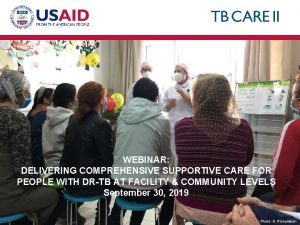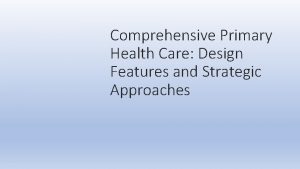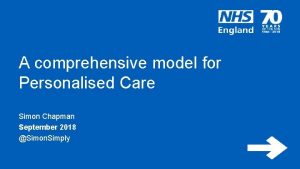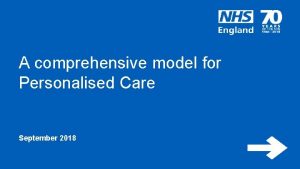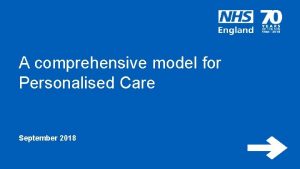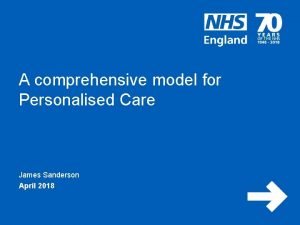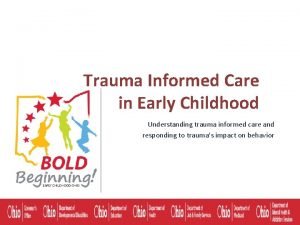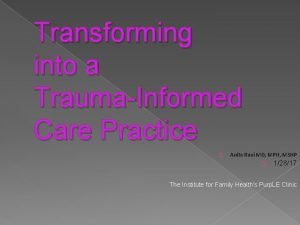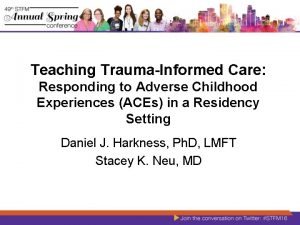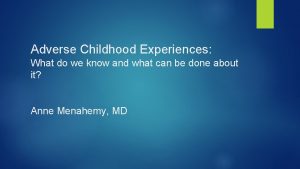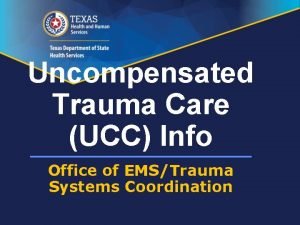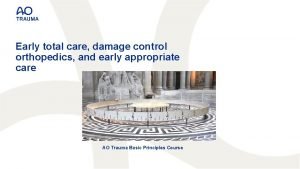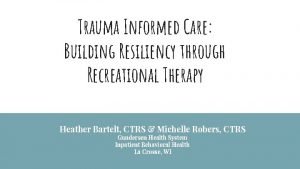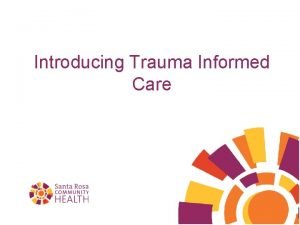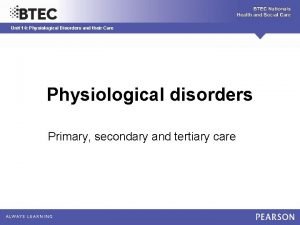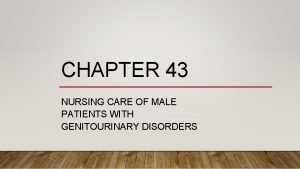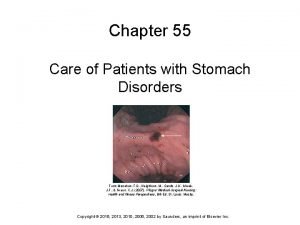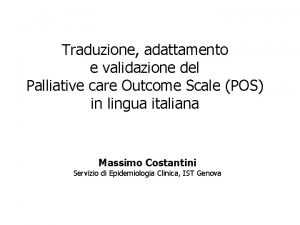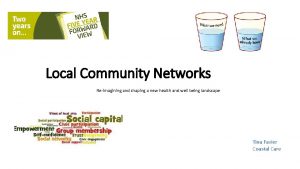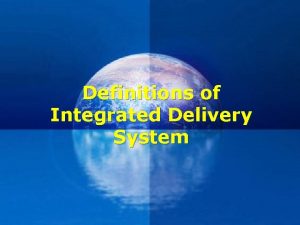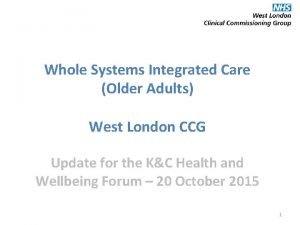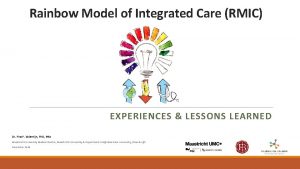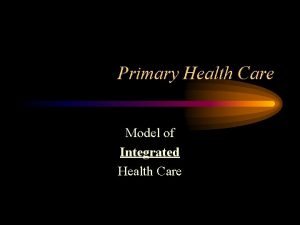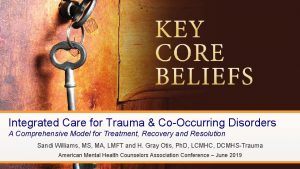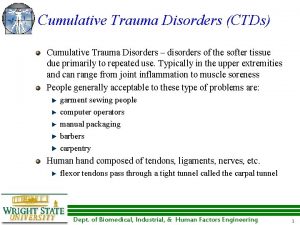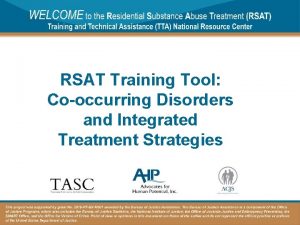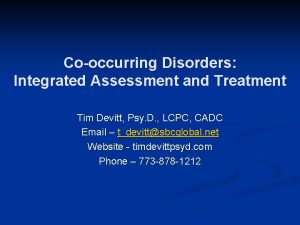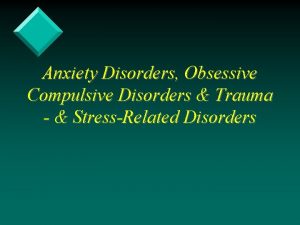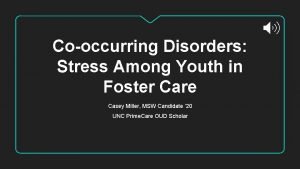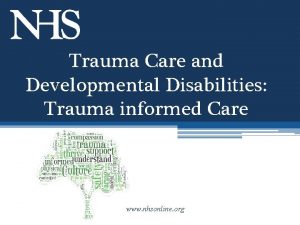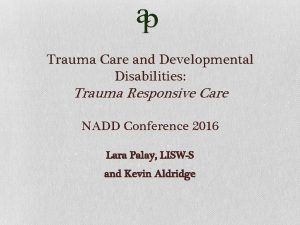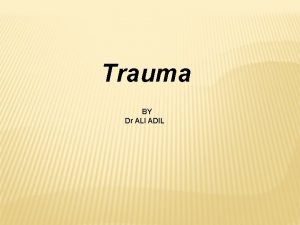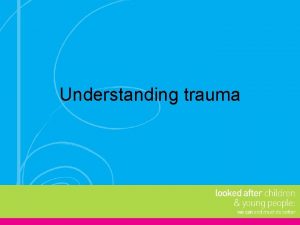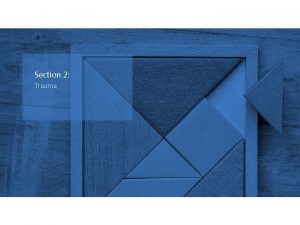Integrated Care for Trauma CoOccurring Disorders A Comprehensive























































































- Slides: 87

Integrated Care for Trauma & Co-Occurring Disorders A Comprehensive Model for Treatment, Recovery and Resolution Sandi Williams, MS, MA, LMFT and H. Gray Otis, Ph. D, LCMHC, DCMHS-Trauma American Mental Health Counselors Association Conference – June 2019

Presentation Contributors Gray Otis, Ph. D, LCMHC, CCMHC, DCMHS-T q AMHCA Diplomate, Clinical Mental Health Specialist in Trauma q He has been the clinical director of residential and intensive out patient treatment programs q Private practice – owner Vanguard Behavioral Health Sandi Williams, MS, MA, LMFT q Specialist in trauma resolution and family counseling q She has co-facilitated a residential treatment program q Private practice – owner of the Meadows Counseling, adjunct professor at Utah Valley University James Messina, Ph. D, Psychologist, CCMHC, DCMHS-T q AMHCA Diplomate, Clinical Mental Health Specialist in Trauma q He has served as a professor at Troy State University q Developed a library of on-line resources available at Coping. US © 2018 KEY CORE BELIEFS. ALL RIGHTS RESERVED. 2

Integrated Care for Trauma & Co-Occurring Disorders 1. An operational definition of trauma and chronic distress 2. The role of shame in unresolved trauma 3. Trauma assessment 4. Best practice interventions 5. Practical individual treatment approaches © 2018 KEY CORE BELIEFS. ALL RIGHTS RESERVED. 3

A Client Resource for Trauma Resolution… KEY CORE BELIEFS Unlocking the HEART of Happiness & Health Amazon – Softcover $15. 95, e. Book $9. 95 Written for the public q Each chapter has workbook activities q Appendix for clinicians q Can be used as an adjunct to therapy q q © 2018 KEY CORE BELIEFS. ALL RIGHTS RESERVED. 4

Added Treatment Resources Free activities for your clients: See Website for access to activities at www. keycorebeliefs. org Future notifications Join our Facebook page to be notified about more information as it becomes available: facebook/keycorebeliefs. org © 2018 KEY CORE BELIEFS. ALL RIGHTS RESERVED. 5

The Trauma Test q The next slide shows two identical dolphins jumping out of the water. q A scientific study showed that, in spite of these two alike dolphins, individuals with unresolved trauma will find differences. q Look at both dolphins. q The more differences you find between the dolphins, the more trauma or chronic distress you have experienced. © 2018 KEY CORE BELIEFS. ALL RIGHTS RESERVED. 6

© 2018 KEY CORE BELIEFS. ALL RIGHTS RESERVED. 7

Points to Consider: q If you experience trauma or chronic distress in your life, you are normal. q Humor is a valuable means for gaining perspective. What can you do to add a little more humor in your therapeutic partnerships? © 2018 KEY CORE BELIEFS. ALL RIGHTS RESERVED. 8

Presentation Outline 1) Understanding Trauma 2) Trauma & Shame 3) Resolving Trauma 4) HEART Factors © 2018 KEY CORE BELIEFS. ALL RIGHTS RESERVED. 9

1) Understanding Trauma © 2018 KEY CORE BELIEFS. ALL RIGHTS RESERVED. 10

Defining Psychic Trauma & Chronic Distress q Overwhelming emotionally traumatic experiences (e. g. sexual assault, combat, etc. ) or q Chronically distressing experiences (e. g. unemployment, criticism, bullying, etc. ) q Mentally unresolved and troubling q Affective disturbance (0 – 10 = 6 or higher) q Physiological manifestations – most often with somatic discomfort q Dysfunctional behavioral patterns e. g. addiction behaviors, anger, exercise, etc. q Environmental triggers stimulate conscious or sub-conscious reactions q May or may not meet DSM-5 criteria. © 2018 KEY CORE BELIEFS. ALL RIGHTS RESERVED. 11

Impact of Psychic Trauma Affect - difficulty regulating emotions due to hyper sensitization Cognition - disturbed mental experiences based on misinterpreted perceptions and trauma triggers Helplessness - resignation to their condition and belief that they can do nothing about it Brain – disrupted neurological and neurotransmitter functioning: limbic emotional processing overrides cerebral cortex reasoning Body – physiological reactions and possible physical impairment Relationships – reduced ability to connect with loved ones (e. g. push-pull relationships demonstrated by borderline clients) © 2018 KEY CORE BELIEFS. ALL RIGHTS RESERVED. 12

Clients’ Vantage Point Traumatized individuals do not just remember the memory, they are the memory. Trauma resolution is evidenced when clients observe their experience as a normalized narrative memory. © 2018 KEY CORE BELIEFS. ALL RIGHTS RESERVED. 13

Hidden Causes of Disorders 1. Rule out neurological & physiological causes Endocrine – e. g. post partum, Klinefelter’s syndrome, etc. Biological – e. g. coronary cytokine proteins, hypoglycemia Accidents & Injuries – e. g. concussions. m. TBI, etc. Drug Interactions – medications, OTCs, & herbal remedies 2. Check for family issues or interpersonal conflicts 3. Employ the ACE for all ages 4. Look for signs of unresolved trauma or chronic distress When Psychological Problems Mask Medical Disorders: James Morrison, M. D. © 2018 KEY CORE BELIEFS. ALL RIGHTS RESERVED. 14

Trauma or Chronic Distress q PTSD, Complex trauma, m. TBI q Moral injury – damage to one’s psychological state when a person perpetrates, witnesses, or fails to prevent acts that transgress one's own moral beliefs, values, or ethical codes of conduct q Developmental trauma, Reactive attachment disorder q Chronic distress (e. g. living with a narcissistic parent or spouse, emotional bullying, sibling intimidation, ACE [or adult] conditions) How many of you are in practice? Of those you see, what percentage have one or more of the above? © 2018 KEY CORE BELIEFS. ALL RIGHTS RESERVED. 15

Understanding the Pieces of the Puzzle q Trauma and chronic distress is pervasive in individuals with DSM V psychological & personality disorders q Trauma informed care is an imperative q Effective trauma treatment is the single most important therapeutic intervention © 2018 KEY CORE BELIEFS. ALL RIGHTS RESERVED. 16

Putting the Pieces Together q Trauma and chronic distress pervasive in individuals with DSM V q q psychological & personality disorders Trauma informed care is an imperative Effective trauma treatment is the single most important therapeutic intervention Understanding trauma and chronic distress helps us make sense of the pieces for ourselves and for our clients. Effective trauma treatment distinguishes you as an effective Mental Health Care Provider © 2018 KEY CORE BELIEFS. ALL RIGHTS RESERVED. 17

Our Thesis q Trauma or chronic distress results in negative shifts in an individual’s self-beliefs q These beliefs are the basis of an individual’s sense of self q Negative Core Beliefs erodes self-identity, affects perceptions, alters emotional reactions, disrupts cognitive abilities, & disorders behaviors q Converting Negative Core Beliefs into Positive Core Beliefs results in symptom alleviation and disorder resolution We propose that the concepts presented in KEY CORE BELIEFS offer a therapeutic focus for any therapy modality © 2018 KEY CORE BELIEFS. ALL RIGHTS RESERVED. 18

Key Core Beliefs: What Lies Beneath Trauma We propose that Negative Core Beliefs are schemas that lie at the genesis of trauma and nearly all mental health disorders. Through the transformation of these injurious self-beliefs to Positive Core Beliefs, depression, anxiety, and trauma will be resolved with lasting results. © 2018 KEY CORE BELIEFS. ALL RIGHTS RESERVED. 19

Key Core Beliefs Defined Powerfully held convictions about self: q Consistent over time q Can be either conscious or subconscious Based on prior experiences in childhood, adolescence, and adulthood q q Strongly linked to who we are – our unique sense of self q Can often be expressed as “I am. . . ” Statements (e. g. “I am a competitive person. . . I am competitive”) © 2018 KEY CORE BELIEFS. ALL RIGHTS RESERVED. 20

Identifying Negative Core Beliefs How many of you have heard these comments like these in your practice? © 2018 KEY CORE BELIEFS. ALL RIGHTS RESERVED. 21

Key Core Beliefs q q q We accept our Key Core Beliefs as true – but – many are mistaken Based on our experiences, we continually create self-beliefs – constructed reality of the self Ø Negative Core Beliefs generally arise out of personally adverse interactions (“My friends don’t want to spend time with me. . . I am unattractive. ”) Each self-belief is either a Negative Core Belief or Positive Core Belief Ø q These self-beliefs filter our perceptions, thoughts, emotions, and actions. Positive Core Beliefs arise out of personally affirmative interactions (“My teacher thinks I good at math. I must be pretty smart. . . I am smart. ”) q The accumulation of Key Core Beliefs develops our Self-Belief Identity 22 © 2018 KEY CORE BELIEFS. ALL RIGHTS RESERVED.

Accumulating Key Core Beliefs Throughout the lifespan, both Positive and Negative Core Beliefs accumulate © 2018 KEY CORE BELIEFS. ALL RIGHTS RESERVED. 23

Accumulating Key Core Beliefs Throughout the lifespan, both Positive and Negative Core Beliefs accumulate Self. Belief Identity © 2018 KEY CORE BELIEFS. ALL RIGHTS RESERVED. If Positive Core Beliefs predominate, the individual generally develops a constructive Self-Belief Identity 24

Accumulating Key Core Beliefs Throughout the lifespan, both Positive and Negative Core Beliefs accumulate Self. Belief Identity If Positive Core Beliefs predominate, the individual generally develops a constructive Self-Belief Identity However, if Negative Core Beliefs prevail, how would the individual be likely to perceive his or her Self-Belief Identity? © 2018 KEY CORE BELIEFS. ALL RIGHTS RESERVED. 25

Self-Belief Identity Our Self-Belief Identity creates either an antagonistic sense of self or a beneficial sense self: I am diabetic, I am sick – or – Self. Belief Identity © 2018 KEY CORE BELIEFS. ALL RIGHTS RESERVED. 26

Self-Belief Identity Our Self-Belief Identity creates either an antagonistic sense of self or a beneficial sense self: I am diabetic, I am sick – or – I have diabetes but I am tough and pretty healthy Self. Belief Identity © 2018 KEY CORE BELIEFS. ALL RIGHTS RESERVED. 27

Self-Belief Identity Our Self-Belief Identity creates either an antagonistic sense of self or a beneficial sense self: I am diabetic, I am sick – or – I have diabetes but I am tough and pretty healthy Self. Belief Identity © 2018 KEY CORE BELIEFS. ALL RIGHTS RESERVED. I am fat, I am ugly – or – 28

Self-Belief Identity Our Self-Belief Identity creates either an antagonistic sense of self or a beneficial sense self: I am diabetic, I am sick – or – I have diabetes but I am tough and pretty healthy Self. Belief Identity I am fat, I am ugly – or – I am healthy but I could lose some weight © 2018 KEY CORE BELIEFS. ALL RIGHTS RESERVED. 29

Self-Belief Identity Our Self-Belief Identity creates either an antagonistic sense of self or a beneficial sense self: I am diabetic, I am sick – or – I have diabetes but I am tough and pretty healthy Self. Belief Identity I am fat, I am ugly – or – I am healthy but I could lose some weight Skilled therapists can help individuals develop added Positive Core Beliefs and a stronger, more constructive Self-Belief Identity © 2018 KEY CORE BELIEFS. ALL RIGHTS RESERVED. 30

Crucial Stories q We will relate a few stories as case studies q All of these accounts are based on people we have seen q Our goal is to present practical applications that can be used in your practice q Feel free to ask questions © 2018 KEY CORE BELIEFS. ALL RIGHTS RESERVED. 31

Story #1 § Who: Male Young Adult Client § What: seeks therapy for help with healthy relationships § When: target event thought to be child of divorced parents § Why: found himself in a serious relationship § How: Chapter 1 Additional Activity © 2018 KEY CORE BELIEFS. ALL RIGHTS RESERVED. 32

Additional Activity Chapter 1: Creating Key Core Beliefs © 2018 KEY CORE BELIEFS. ALL RIGHTS RESERVED. 33

2) Trauma & Shame © 2018 KEY CORE BELIEFS. ALL RIGHTS RESERVED. 34

Quiz: Negative to Positive Core Beliefs Negative Core Beliefs What would be a alternative Positive Core Belief? I am alone. I am hopeless. I am depressed. I am angry. I am critical. I am addicted. I am ashamed. I am lazy. I am unlovable. © 2018 KEY CORE BELIEFS. ALL RIGHTS RESERVED. 35

Quiz: Negative to Positive Core Beliefs Negative Core Beliefs Positive Core Belief? I am alone. I am friendly. I am hopeless. I am hopeful. I am depressed. I am optimistic. I am angry. I am calm. I am critical. I am accepting. I am addicted. I am healthy. I am ashamed. I am okay. I am lazy. I am conscientious. I am unlovable. I am worthy to be loved. © 2018 KEY CORE BELIEFS. ALL RIGHTS RESERVED. 36

Distinguishing Between Guilt and Shame GUILT: “I did something wrong or terrible” Guilt motivates us to change SHAME: “There is something wrong with me – I am terrible” Shame beliefs lead us to believe that we cannot change To resolve mental health disorders, mental health counselors must be skilled in helping individuals transform shame-based Negative Core Beliefs © 2018 KEY CORE BELIEFS. ALL RIGHTS RESERVED. 37

Shame-Based Negative Core Beliefs Etiology Many Negative Core Beliefs originate from trauma or chronic distress q For example – use of the Adverse Childhood Experience questions: “Did a parent or other adult in the household often or very often… Swear at you, insult you, put you down, or humiliate you? ” q Individuals suffer loss of attachment, low-grade anxiety, cultural conflicts, etc. q Deep seated emotions associated with shame may be manifested in any DSM disorder or medical condition (e. g. “I was often put down. . . I am worthless. ”) q By attempting to numb severe negative emotions and shame, individuals simultaneously numb out joy and love q Often, there is a horrifying sense of isolation & helplessness © 2018 KEY CORE BELIEFS. ALL RIGHTS RESERVED. 38

Exercise: Shame-Based Beliefs Identify possible Shame Based, Negative Core Beliefs Teen-ager who was sexually abused in childhood I am dirty, disgusting, undeserving, contemptible, etc. Veteran whose close friend died in combat I am cowardly, deserve to die, disloyal, etc. Woman who was emotionally devastated by divorce I am unattractive, a failure, broken, etc. An adult who was extensively criticized as a child I am stupid, a mess, disappointing, etc. © 2018 KEY CORE BELIEFS. ALL RIGHTS RESERVED. 39

Other Shame Related Negative Core Beliefs What is wrong with me? Why can’t I ______? Primary fear – inherent shame-based Negative Core Belief: ‘There is something fundamentally wrong with me’ ‘I can’t change – I am just an angry person’ 40 © 2018 KEY CORE BELIEFS. ALL RIGHTS RESERVED.

Other Shame Related Negative Core Beliefs What is wrong with me? Why can’t I ______? Primary fear – inherent shame-based Negative Core Belief: ‘There is something fundamentally wrong with me’ ‘I can’t change – I am just an angry person’ Probably the most important shame selfbelief – ‘Who could love an angry person? I’m unworthy to be loved’ 41 © 2018 KEY CORE BELIEFS. ALL RIGHTS RESERVED.

The Transformation of Shame Self-Beliefs q q q If the beliefs are resolved, the symptoms resolve All of these disorders have shamebased, Negative Core Beliefs Outcome research shows that addressing underlying shame is highly effective in treating many DSM disorders including anxiety, PTSD, depression, addictions, and compulsive behaviors. Shame self-beliefs can be transformed into constructive, POSITIVE SELF- BELIEFS Mental health counselors need evidenced-based approaches to treat the underlying basis of cooccurring disorders 42 © 2018 KEY CORE BELIEFS. ALL RIGHTS RESERVED.

Review of Negative Core Beliefs Shame-based Negative Core Beliefs create emotional dysregulation To cope, clients turn to alcohol, drugs, work, exercise, religion, politics, or any of a multitude highly creative, compulsive behaviors q Negative Core Beliefs eclipse everything else mentally & emotionally q We must go beyond treating symptoms q No counselor can create Positive Core Beliefs q However, we can create the conditions to transform Negative Core Beliefs into Positive Self-Beliefs © 2018 KEY CORE BELIEFS. ALL RIGHTS RESERVED. 43

Relationship of Shame to Trauma The Affect Cognition Model How Emotion Evokes Cognition, Behavior, Key Core Beliefs, and Self-Belief Identity © 2018 KEY CORE BELIEFS. ALL RIGHTS RESERVED. 44

Limbic – Cerebral Processing Limbic (primitive? ) system processing of events occurs in micro seconds. It is extremely sophisticated & critical to our functional success. © 2018 KEY CORE BELIEFS. ALL RIGHTS RESERVED. 45

The Affect Cognition Process 2. Primary Feeling 5. Actuated Behavior 6. Competency Appraisal 7. Self-Belief Identity tex or la da us es us m ala s on –P th po Hy rv Ne p am oc o. C 4. Principal Motivation yg pp Hi y or s– mu ala ns Th Se 3. Secondary Emotion Ne 1. Preconscious Affect Am Activating Perception Limbic System Processing Cerebral Processing (Primitive Brain) © 2018 KEY CORE BELIEFS. ALL RIGHTS RESERVED. (Left, Right Hemispheres) 46

The Affect-Cognition Model Accumulated Experiences & Self-Beliers Activating Perception 1. Preconscious Affect Limbic Processed: 2. Primary Feelings I feel: 3. Secondary Emotions I sense I am: I’m moved by: q Enjoyment q Worthy q Interest q Acceptable q Surprise q Capable q Fright q Accused q Mad q q Distress q Guilty q Sad q q Irritation q Rejected q Anxious q Disgust q Unlovable q Loathing q Powerless q Humiliation q Glad 4. Principal Motivation 5. Activated Behaviors I choose to: q Desire q Soothe Self q Concern q Engage Fear q Fight Apathy q Flight q Freeze q Attack Self 6. Competency Appraisal I behaved: 7. Core Belief Shaping I believe I am: q Sensibly q Competent & Worthy to be Loved q Ineptly q Inadequate & Less Worthy to be Loved Reassuring Experiences Discouraging Experiences Regardless if an experience is Reassuring or Discouraging, it accumulates and adds to self-beliefs about our competency and worthiness to be loved © 2018 KEY CORE BELIEFS. ALL RIGHTS RESERVED. 47

The Affect-Cognition Model Accumulated Experiences & Self-Beliers Activating Perception 1. Preconscious Affect Limbic Processed: 2. Primary Feelings I feel: 3. Secondary Emotions I sense I am: I’m moved by: q Enjoyment q Worthy q Interest q Acceptable q Surprise q Capable q Fright q Accused q Mad q q Distress q Guilty q Sad q q Irritation q Rejected q Anxious q Disgust q Unlovable q Loathing q Powerless q Humiliation q Glad 4. Principal Motivation 5. Activated Behaviors I choose to: q Desire q Soothe Self q Concern q Engage Fear q Fight Apathy q Flight q Freeze q Attack Self 6. Competency Appraisal I behaved: 7. Core Belief Shaping I believe I am: q Sensibly q Competent & Worthy to be Loved q Ineptly q Inadequate & Less Worthy to be Loved Reassuring Experiences Discouraging Experiences But what happens when an experience is so emotionally disordered and confusing that the individual cannot make sense of it? © 2018 KEY CORE BELIEFS. ALL RIGHTS RESERVED. 48

The Affect-Cognition Model Accumulated Experiences & Self-Beliers Activating Perception 1. Preconscious Affect Limbic Processed: q Enjoyment 2. Primary Feelings I feel: q 3. Secondary Emotions I sense I am: Worthy q 4. Principal Motivation I’m moved by: Glad q q Interest q Acceptable q Surprise q Capable q Fright q Accused q Mad q q Distress q Guilty q Sad q q Irritation q Rejected q Anxious q Disgust q Unlovable q Loathing q Powerless q Humiliation Acute Humiliation q Desire 5. Activated Behaviors I choose to: q Concern Soothe Self q Engage Fear q Fight Apathy q Flight q Freeze q Attack Self 6. Competency Appraisal I behaved: q Sensibly I believe I am: q Competent & Worthy to be Loved Reassuring Experiences q Ineptly q Inadequate & Less Worthy to be Loved q Inexplicably q Ashamed & Unworthy to be Loved Discouraging Experiences Intensely Powerless 7. Core Belief Shaping Hyper Anxious Amplified Fear Addiction-like Attack Self Disordered Emotions Traumatic or Chronic Distress Experiences Easily Aroused Emotions Impeded Development © 2018 KEY CORE BELIEFS. ALL RIGHTS RESERVED. Persistent Shame Fragmented Memory Unprocessed Experience 49

The Affect-Cognition Model Accumulated Experiences & Self-Beliers Activating Perception 1. Preconscious Affect Limbic Processed: 2. Primary Feelings I feel: 3. Secondary Emotions I sense I am: 4. Principal Motivation I’m moved by: q Enjoyment q Worthy q Interest q Acceptable q Surprise q Capable q Fright q Accused q Mad q q Distress q Guilty q Sad q q Irritation q Rejected q Anxious q Disgust q Unlovable Triggered q Loathing q Powerless Perception q Humiliation Acute Humiliation q Glad 5. Activated Behaviors I choose to: q Desire q Soothe Self q Concern q Engage Fear q Fight Apathy q Flight q Freeze q Attack Self I behaved: 7. Core Belief Shaping I believe I am: q Sensibly q Competent & Worthy to be Loved q Ineptly q Inadequate & Less Worthy to be Loved q Inexplicably q Ashamed & Unworthy to be Loved Reassuring Experiences Discouraging Experiences Intensely Powerless 6. Competency Appraisal Hyper Anxious Amplified Fear Addiction-like Attack Self Traumatic or Chronic Distress Experiences Easily Aroused Emotions Impeded Development © 2018 KEY CORE BELIEFS. ALL RIGHTS RESERVED. Persistent Shame Fragmented Memory Unprocessed Experience 50

Psychic Effects Trauma can remain unprocessed for years Acute Humiliation Intensely Powerless Hyper Anxious Amplified Fear Addiction Like Attack-Self Traumatic or Chronic Distress Experiences Easily Aroused Emotions Impeded Development Persistent Shame Fragmented Memory Unprocessed Experience This provokes an unending series of effects © 2018 KEY CORE BELIEFS. ALL RIGHTS RESERVED. 51

Affect Cognition Proposes Clients can: 1. Increase awareness of their Negative Core Beliefs 2. Cultivate more responsibility for thoughts & behaviors 3. Develop alternative Positive Core Beliefs 4. Improve self-soothing, empathy, & other EQ skills 5. Effectively process trauma The Affect Cognition Model is a tool to understand & normalize inexplicable trauma as a foundation to developing Positive Core Beliefs © 2018 KEY CORE BELIEFS. ALL RIGHTS RESERVED. 52

Key Core Beliefs Act as Filters Each event in our lives is influenced by our previous Key Core Beliefs and the emotions related to these deeply held convictions. As we perceive a new experience, our Key Core Beliefs immediately filter and influence our perceptions of the event. To illustrate: © 2018 KEY CORE BELIEFS. ALL RIGHTS RESERVED. 53

Key Core Beliefs Act as Filters Each event in our lives is influenced by our previous Key Core Beliefs and the emotions related to these deeply held convictions. As we perceive a new experience, our Key Core Beliefs immediately filter and influence our perceptions of the event. To illustrate: © 2018 KEY CORE BELIEFS. ALL RIGHTS RESERVED. 54

Story #2 Who: Middle-Age Widow What: seeks therapy for grief counseling When: 2 years after husband’s passing Why: family’s urging to get help How: Chapter 2 Additional Activity © 2018 KEY CORE BELIEFS. ALL RIGHTS RESERVED. 55

Additional Activity Chapter 2: Exploring HEART Collage © 2018 KEY CORE BELIEFS. ALL RIGHTS RESERVED. 56

3) Resolving Trauma © 2018 KEY CORE BELIEFS. ALL RIGHTS RESERVED. 57

Story 3 Who: Middle-Age Married Woman with Children What: seeks therapy for … guilt When: target event thought to be freshman year at college Why: ran into a “reminder” of the event How: Chapter 11 Additional Activity © 2018 KEY CORE BELIEFS. ALL RIGHTS RESERVED. 58

Additional Activity Chapter 11: Developing Forgiveness © 2018 KEY CORE BELIEFS. ALL RIGHTS RESERVED. 59

Trauma & Chronic Distress Behaviors q IED q Workaholic Behaviors q OCD q Fitness Junkies q OCPD q Psychotic disorders q Paranoia q Somatic conditions q Sexual Compulsions q Other? All addiction-like behaviors numb psychic pain by producing the internal release of epinephrine and other hormones © 2018 KEY CORE BELIEFS. ALL RIGHTS RESERVED. 60

Borderline Personality What is the percentage of individuals with diagnosed Borderline Personality Disorder who do not have related, unresolved psychic trauma or chronic distress? © 2018 KEY CORE BELIEFS. ALL RIGHTS RESERVED. 61

Substance Dependence What is the percentage of individuals with diagnosed substance dependence disorders who do not have related, unresolved psychic trauma or chronic distress? © 2018 KEY CORE BELIEFS. ALL RIGHTS RESERVED. 62

Considerations n Not all conditions are a result of trauma or chronic distress n Psychic trauma does not excuse wrongful behavior but it does help us understand it n In all cases, trauma & chronic distress should be considered as a underlying cause to presenting symptoms n When Negative Core Beliefs are transformed into Positive Core Beliefs, trauma is effectively & permanently resolved The concepts presented in KEY CORE BELIEFS offer a therapeutic focus for any therapy modality © 2018 KEY CORE BELIEFS. ALL RIGHTS RESERVED. 63

Measuring Trauma & Chronic Distress Trauma and, or chronic distress is experienced by almost everyone It is personal & highly subjective (e. g. some are resilient, others not) Measure: Subjective Units of Disturbance (SUDs) “Tell me about a disturbing event that you experienced. ” “On a scale from 0 to 10, how disturbing was this? ” “From your earliest memories until now, what other events have been disturbing to you – 0 to 10? ” Watch for signs of emotion or bodily reactions © 2018 KEY CORE BELIEFS. ALL RIGHTS RESERVED. 64

Adverse Childhood (& Adult) Experiences Please indicate if you have ever been subjected to any experiences listed below? (Check all that apply and list your age at that time. ) q Death of a loved one, separation from loved one, divorce of parents, loss of a partner, etc. q Domestic violence, parents fighting, family member addiction, imprisonment, suicide, etc. q Crime such as a robbery, involvement in violence such as a fight, criminal assault, etc. q Life threatening experience such as a serious car accident, combat, having cancer, etc. q Major injury, significant fall, serious burns, disfigurement, chronic illness, hospitalizations, etc. q Verbal abuse such as repeatedly criticized, being told you were stupid, lazy, worthless, etc. q Emotional abuse such as being neglected, repeatedly ignored, harassed, bullied, etc. q Physical abuse such as being hit, forcibly held, shoved, shaken, grabbed, slapped, etc. q Sexual mistreatment such as harassment, rape, unwanted touching, affection or sex, etc. q Any other disturbing event such as being intimidated or witnessing any of the above. © 2018 KEY CORE BELIEFS. ALL RIGHTS RESERVED. 65

Assessment Summary 1. Be aware that it is easy for clients and clinicians to overlook or dismiss trauma & chronic distress or think they have been resolved 2. There is rarely any disorder that does not have contributing trauma or chronic distress elements 3. When in doubt, you must rule trauma out (as well as chronic distress) 4. Unprocessed distress will have ‘emotional tags’ in the form of anxiety, tears, choking on words, rage, resentment, depression, compulsions, etc. 5. Resolved trauma & chronic distress resolves ‘emotional tags’ © 2018 KEY CORE BELIEFS. ALL RIGHTS RESERVED. 66

Therapeutic Interventions 1. Progressive Relaxation & Visualization 2. Eye Movement Desensitization & Reprocessing – EMDR (http: //www. emdr. com) (Not REM Therapy) 3. Acupressure Approaches Thought Field Therapy – TFT (http: //www. tftrx. com/) Emotional Self-Management – ESM (www. instantemotionalhealing. com) Emotional Freedom Techniques – EFT (www. emofree. com) 4. CBT, CPT, Other? All licensed counselors should learn an evidence-based intervention © 2018 KEY CORE BELIEFS. ALL RIGHTS RESERVED. 67

Treatment Adjuncts q Rhythmic exercise q Walking, gardening, other outdoor activities (not sky-diving? ) q Dance q Tai chi, ‘soft’ karate, other martial arts q Yoga q Mindfulness, meditation q Key Core Beliefs – chapter activities & on-line activities © 2018 KEY CORE BELIEFS. ALL RIGHTS RESERVED. 68

How to Change Negative Core Beliefs The therapeutic process to transform any Negative Core Belief: 1. BECOME AWARE: Identify the Negative Core Belief 2. CREATE: Devise an alternative, desired Positive Core Belief 3. ACT: Foster behaviors that reinforce the Positive Core Belief 4. PRACTICE: Consistently act to strengthen the Positive Core Belief © 2018 KEY CORE BELIEFS. ALL RIGHTS RESERVED. 69

Positive Core Belief Development 1. BECOME AWARE: Identify the Negative Core Belief “I am scared around all strangers. ” My Core Belief is: “I am fearful. ” 2. CREATE: Devise a desired, alternative Positive Core Belief “I want to be self-confident. ” My Core Belief will be: “I am confident. ” 3. ACT: Foster behaviors that reinforce the Positive Core Belief “From now on, when someone greets me I will say, Hi. ” 4. PRACTICE: Consistently act to strengthen the Positive Core Belief. “I will make a habit of this every day even if I feel anxious. ” Takes about 49 days of daily conscientious effort © 2018 KEY CORE BELIEFS. ALL RIGHTS RESERVED. 70

Assessing the Quality of Life Daily estimate the quality of life on a scale of 1 to 7 by the degree it is lived with empathy, caring, and connection. Shame, Fear, Isolation Empathy, Caring, Connection Fear of self and our self-beliefs has an effective anecdote This builds Positive Core Beliefs: I am empathetic and caring © 2018 KEY CORE BELIEFS. ALL RIGHTS RESERVED. 71

4) HEART Factors © 2018 KEY CORE BELIEFS. ALL RIGHTS RESERVED. 72

HEART: The 5 Essentials of Integrated Well-being Health—physical wellness based on principles of healthy living © 2018 KEY CORE BELIEFS. ALL RIGHTS RESERVED. 73

HEART: The 5 Essentials of Integrated Well-being Health—physical wellness based on principles of healthy living Emotions—emotional balance through self-understanding © 2018 KEY CORE BELIEFS. ALL RIGHTS RESERVED. 74

HEART: The 5 Essentials of Integrated Well-being Health—physical wellness based on principles of healthy living Emotions—emotional balance through self-understanding Awareness—conscious use of our mental abilities © 2018 KEY CORE BELIEFS. ALL RIGHTS RESERVED. 75

HEART: The 5 Essentials of Integrated Well-being Health—physical wellness based on principles of healthy living Emotions—emotional balance through self-understanding Awareness—conscious use of our mental abilities Relationships—caring and satisfying connections with others © 2018 KEY CORE BELIEFS. ALL RIGHTS RESERVED. 76

HEART: The 5 Essentials of Integrated Well-being Health—physical wellness based on principles of healthy living Emotions—emotional balance through self-understanding Awareness—conscious use of our mental abilities Relationships—caring and satisfying connections with others Transcendence—enrichment through inspiring influences © 2018 KEY CORE BELIEFS. ALL RIGHTS RESERVED. 77

We All Have Key Core Beliefs Regarding: Health I am healthy I am uncoordinated Emotions I am coolheaded I am resentful Awareness I am intelligent I am not musical Relationship I am kind I am dishonest Transcendence I am spiritual I am uninspired These five essentials are all Key Core Beliefs © 2018 KEY CORE BELIEFS. ALL RIGHTS RESERVED. 78

The Personal HEART Review Included in Chapter 2 – takes about 15 minutes Helpful, encouraging self-assessment Examples: q Health: I enjoy healthful activities, such as walking, five or more days a week. q Emotions: I know how to soothe myself when I feel distressed. q Awareness: I have a generally positive, realistic perception of myself. q Relationships: In each of my relationships, I create at least five positive interactions for every negative one. q Transcendence: I practice thankfulness every day and frequently express my appreciation. © 2018 KEY CORE BELIEFS. ALL RIGHTS RESERVED. 79

HEART Routines in Trauma Recovery Those who experience trauma, often believe they are helpless They are convinced they are along and powerless HEART applications support a sense of personal effectiveness As noted, the five HEART essentials fortify Positive Core Beliefs The integrated effectiveness of the five essentials reinforces attention physical wellness, psychological well-being, & relational connections All of the essentials build greater resilience © 2018 KEY CORE BELIEFS. ALL RIGHTS RESERVED. 80

Additional Considerations Trauma and Chronic Distress are not easily resolved Related Negative Core Beliefs become entrenched & reinforced Change a habit = 21 days Change a core belief = 49 days Work in session vice daily work between sessions: 1. BECOME AWARE: Identify the Negative Core Belief 2. CREATE: Devise an alternative, desired Positive Core Belief 3. ACT: Foster behaviors that reinforce the Positive Core Belief 4. PRACTICE: Consistently act to strengthen the Positive Core Belief At each session, assess for trauma resolution e. g. Do you remember what we discussed last time? From 0 to 10, what is the level of distress? © 2018 KEY CORE BELIEFS. ALL RIGHTS RESERVED. 81

Helps for Therapeutic Counseling q Devise experiments to try better self-beliefs q Catch “Negative Core Belief” statements q Do an accuracy assessments q q What percentage of the time is this self-belief is accurate? q Who thinks that this belief is truthful? q What purpose, if any, is this belief serving you? q What ideas do you have about countering this self-belief? Immediately, support them in creating truthful “Positive Core Beliefs” © 2018 KEY CORE BELIEFS. ALL RIGHTS RESERVED. 82

Simulations q Recall a time that you had this belief q In sessions, step through: q BECOME AWARE: Identify the Negative Core Belief q CREATE: Devise an alternative Positive Core Belief q ACT: Immediately act to reinforce the Positive Core Belief q PRACTICE: Consistently do acts that strengthen the Positive Core Belief q Encourage individuals to keep logs of their beliefs q Focus on the most crucial Positive Core Belief: “I am worthy to love and to be loved” © 2018 KEY CORE BELIEFS. ALL RIGHTS RESERVED. 83

KEY CORE BELIEFS: Unlocking the HEART of Happiness & Health Key Core Beliefs can be therapeutic help for clients to read & apply in recovering from trauma A one-page chart at Appendix A is a helpful overview of the book’s concepts for clients For more information, please refer to Appendix D, "Notes for Mental Health Professionals" © 2018 KEY CORE BELIEFS. ALL RIGHTS RESERVED. 84

Summary When we work with a person who has suffered from trauma or chronic distress, we know there is nothing innately wrong with them Although the person has been injured – both physical and psychological injuries heal naturally Unfortunately, our client likely does not believe this We know that the person is already healing because they have sought out help We believe that they will be made whole … © 2018 KEY CORE BELIEFS. ALL RIGHTS RESERVED. 85

Because we believe this, our work will gently lead them to believe in their own recovery and resilience © 2018 KEY CORE BELIEFS. ALL RIGHTS RESERVED. 86

With appreciation for all your dedication! Please feel free to email us Gray Otis, LCMHC Sandi Williams, LMFT gray_otis@yahoo. com sandi@themeadowscounseling. com © 2018 KEY CORE BELIEFS. ALL RIGHTS RESERVED. 87
 Levels of care primary secondary tertiary quaternary
Levels of care primary secondary tertiary quaternary Comprehensive care plan
Comprehensive care plan Comprehensive primary health care definition
Comprehensive primary health care definition Comprehensive model of personalised care
Comprehensive model of personalised care Comprehensive model of personalised care
Comprehensive model of personalised care Personalised care operating model
Personalised care operating model Comprehensive model of personalised care
Comprehensive model of personalised care 4 r's trauma informed care
4 r's trauma informed care Lgbtq trauma informed care
Lgbtq trauma informed care Dr anita ravi
Dr anita ravi Pillars of trauma informed care
Pillars of trauma informed care 4 r's trauma informed care
4 r's trauma informed care Www.dfps.state.tx.us/training/trauma informed care/
Www.dfps.state.tx.us/training/trauma informed care/ Tina champagne sensory modulation and environment
Tina champagne sensory modulation and environment Uncompensated trauma care application texas
Uncompensated trauma care application texas Early total care
Early total care Trauma-informed care cheat sheet
Trauma-informed care cheat sheet Trauma informed icebreakers
Trauma informed icebreakers Trauma informed care for foster youth
Trauma informed care for foster youth Unit 14 physiological disorders and their care
Unit 14 physiological disorders and their care Physiological disorders and their care
Physiological disorders and their care Nursing care of male patients with genitourinary disorders
Nursing care of male patients with genitourinary disorders Pneumatic reduction of intussusception
Pneumatic reduction of intussusception Chapter 55 care of patients with stomach disorders
Chapter 55 care of patients with stomach disorders North east and north cumbria integrated care system
North east and north cumbria integrated care system Mercy maricopa
Mercy maricopa Validazione pos
Validazione pos Cissbury integrated care
Cissbury integrated care Integrated care delivery system
Integrated care delivery system St charles integrated care centre
St charles integrated care centre Pim valentijn
Pim valentijn Imcc emory
Imcc emory Family integrated care
Family integrated care Integrated primary health care model
Integrated primary health care model Apple health managed care plans
Apple health managed care plans Kontinuitetshantering i praktiken
Kontinuitetshantering i praktiken Novell typiska drag
Novell typiska drag Tack för att ni lyssnade bild
Tack för att ni lyssnade bild Returpilarna
Returpilarna Varför kallas perioden 1918-1939 för mellankrigstiden
Varför kallas perioden 1918-1939 för mellankrigstiden En lathund för arbete med kontinuitetshantering
En lathund för arbete med kontinuitetshantering Personalliggare bygg undantag
Personalliggare bygg undantag Personlig tidbok fylla i
Personlig tidbok fylla i Anatomi organ reproduksi
Anatomi organ reproduksi Förklara densitet för barn
Förklara densitet för barn Datorkunskap för nybörjare
Datorkunskap för nybörjare Tack för att ni lyssnade bild
Tack för att ni lyssnade bild Debatt mall
Debatt mall Autokratiskt ledarskap
Autokratiskt ledarskap Nyckelkompetenser för livslångt lärande
Nyckelkompetenser för livslångt lärande Påbyggnader för flakfordon
Påbyggnader för flakfordon Arkimedes princip formel
Arkimedes princip formel Publik sektor
Publik sektor Urban torhamn
Urban torhamn Presentera för publik crossboss
Presentera för publik crossboss Argument för teckenspråk som minoritetsspråk
Argument för teckenspråk som minoritetsspråk Plats för toran ark
Plats för toran ark Klassificeringsstruktur för kommunala verksamheter
Klassificeringsstruktur för kommunala verksamheter Luftstrupen för medicinare
Luftstrupen för medicinare Claes martinsson
Claes martinsson Centrum för kunskap och säkerhet
Centrum för kunskap och säkerhet Verifikationsplan
Verifikationsplan Mat för idrottare
Mat för idrottare Verktyg för automatisering av utbetalningar
Verktyg för automatisering av utbetalningar Rutin för avvikelsehantering
Rutin för avvikelsehantering Smärtskolan kunskap för livet
Smärtskolan kunskap för livet Ministerstyre för och nackdelar
Ministerstyre för och nackdelar Tack för att ni har lyssnat
Tack för att ni har lyssnat Referat mall
Referat mall Redogör för vad psykologi är
Redogör för vad psykologi är Borstål, egenskaper
Borstål, egenskaper Tack för att ni har lyssnat
Tack för att ni har lyssnat Borra hål för knoppar
Borra hål för knoppar Orubbliga rättigheter
Orubbliga rättigheter Stickprovsvarians
Stickprovsvarians Tack för att ni har lyssnat
Tack för att ni har lyssnat Rita perspektiv
Rita perspektiv Ledningssystem för verksamhetsinformation
Ledningssystem för verksamhetsinformation Tobinskatten för och nackdelar
Tobinskatten för och nackdelar Toppslätskivling effekt
Toppslätskivling effekt Datumr
Datumr Egg för emanuel
Egg för emanuel Elektronik för barn
Elektronik för barn Fredsgudinna pax
Fredsgudinna pax Strategi för svensk viltförvaltning
Strategi för svensk viltförvaltning Var 1721 för stormaktssverige
Var 1721 för stormaktssverige Indikation för kejsarsnitt på moderns önskan
Indikation för kejsarsnitt på moderns önskan Ro i rom pax
Ro i rom pax

